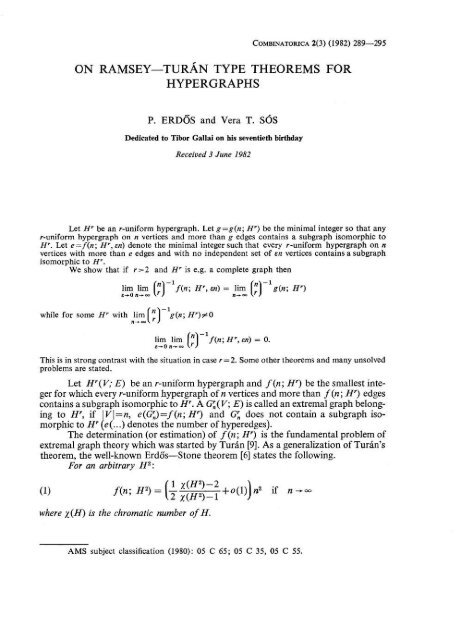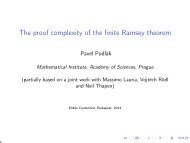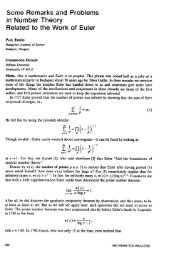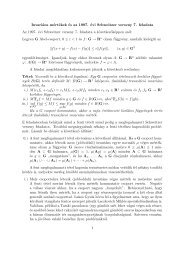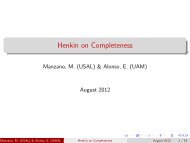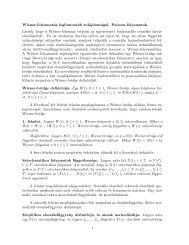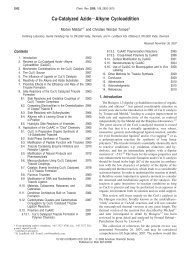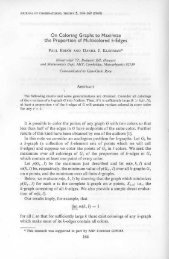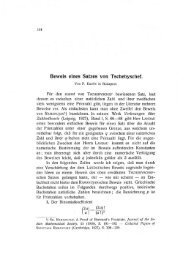ON RAMSEY-TURAN TYPE THEOREMS FOR HYPERGRAPHS
ON RAMSEY-TURAN TYPE THEOREMS FOR HYPERGRAPHS
ON RAMSEY-TURAN TYPE THEOREMS FOR HYPERGRAPHS
You also want an ePaper? Increase the reach of your titles
YUMPU automatically turns print PDFs into web optimized ePapers that Google loves.
COMBINATORKA 2(3) (1982) 289-295<br />
<strong>ON</strong> <strong>RAMSEY</strong>-<strong>TURAN</strong> <strong>TYPE</strong> <strong>THEOREMS</strong> <strong>FOR</strong><br />
<strong>HYPERGRAPHS</strong><br />
P. ERDBS and Vera T. 3%<br />
Dedicated to Tibor Gallai on his seventieth birthday<br />
Received 3 June 1982<br />
Let H’ be an r-uniform hypergraph. Let g=g(n; F) be the minimal integer so that any<br />
r-uniform hypergraph on n vertices and more than g edges contains a subgraph isomorphic to<br />
H’. Let e=f(n; H’, en) denote the minimal integer such that every r-uniform hypergraph on n<br />
vertices with more than e edges and with no independent set of .sn vertices contains a subgraph<br />
isomorphic to H’.<br />
We show that if r=-2 and H’ is e.g. a complete graph then<br />
while for some H’ with lim<br />
lim lirn a -If@; H’, en) = lim (:)-‘g(n; HP)<br />
E-r0 n-=-a 0 r n-00<br />
-‘f(n; H’, m) = 0.<br />
This is in strong contrast with the situation in case r=2. Some other theorems and many unsolved<br />
problems are stated.<br />
Let H’(v; E) be an r-uniform hypergraph and f(n; H’) be the smallest inte-<br />
ger for which every r-uniform hypergraph of n vertices and more than f (n ; H’) edges<br />
contains a subgraph isomorphic to H’. A G; (V; E) is called an extremal graph belong-<br />
ing to H’, if IV]= n, e(G’,)=f(n; IF) and G; does not contain a subgraph iso-<br />
morphic to H’ (e(. . .) denotes the number of hyperedges).<br />
The determination (or estimation) of f(n; H’) is the fundamental problem of<br />
extremal graph theory which was started by Turin [9]. As a generalization of Turan’s<br />
theorem, the well-known Erd&-Stone theorem [6] states the following.<br />
For an arbitrary H2:<br />
f(n; H2) = (; ;;;:;I: +o(l))n2 if n -03<br />
where x(H) is the chromatic number of H.<br />
AMS subject classification (1980): 05 C 65; 05 C 35, 05 C 55.
290 P. ERD&, V. T. SbS<br />
First of all, we remark that for 1-22 almost nothing is known about f(n; II’).<br />
E.g. for the simplest graphs Ki (the complete 3-uniform hypergraph on 4 vertices) or<br />
H3(4; 3) (three triples on four vertices) not even the asymptotic value of f(n; H3) is<br />
known. Turan’s classical conjecture is, that<br />
and it is very probably that<br />
(3) f(n; H3(4; 3)) - +-(J if n --,<br />
As to the general case, it is easy to see that for an arbitrary H’<br />
n-b03 hm ’<br />
0 r -I f(n; H’) = c(F)<br />
exists. It is well-known [4] that c(P) =0 if and only if the vertices of H’ can be split<br />
into r classes so that every edge of H’ meets all r classes.<br />
We observed [q, [I that for r=2, H= Kk (where K, is the complete graph on k<br />
vertices), the extremal graph is stable in the following sense: it contains “very large”<br />
independent sets and if we put on a condition which decreases the size of the maximal<br />
independent set in G,, then the number of edges of the corresponding extremal graphs<br />
gets drastically reduced. More precisely, let f(n; H’, I) be the smallest integer for<br />
which every graph of n vertices and more than f(n; H’, I) edges either contains a<br />
subgraph isomorphic to H’ or it contains an independent set of size 1.<br />
Due to Ramsey’s theorem for fixed H’ and /, f (n; H’, I) =0 if nsR(H’, I).<br />
Therefore, the problem makes sense only in the case when either jY(Hr)I +- or<br />
I-m. Referring to the case r = 2 and H= Kk, we proved<br />
(5) lim lim i<br />
e-0 #I-+=- 0<br />
while by Turitn’s theorem<br />
-‘f(n; Kk,en) =<br />
if k odd<br />
if k even<br />
(For k odd see [5], for k=2 see [l], [8] and for k>2, even see [2].)<br />
In this paper, we investigate analogous problems for hypergraphs. The main<br />
result of this paper is that surprisingly the situation is quite different for hypergraphs.<br />
E.g. for K; (and for a more general class of graphs) the condition that the largest<br />
independent set has size o(n) does not change the situation. We prove<br />
Theorem 1. Let r 23, H’ be an r-uniform hypergraph, E= {h,, . . . , h,} be the edge-set<br />
of Hr. Suppose H’ satisfies the condition<br />
(7)<br />
for every i, 1 s i s m there exist a j f i such that ]h,nhj\ 1 2.
<strong>ON</strong> <strong>RAMSEY</strong>-TUlLhN <strong>TYPE</strong> <strong>THEOREMS</strong> <strong>FOR</strong> HYFERGRAPHS 291<br />
Let lim (‘)->(ni H’)=c(H’) and liiy lil$n( :)->(n; H’, ~n)=c*(H~), Then<br />
It--- r<br />
(8)<br />
c*(H’) = c(H’).<br />
Remark. Condition (7) holds e.g. for K; and also for Hs (4.3).<br />
Proof. Our idea in the proof is that if there are large independent sets in the extremal<br />
graph, we spoil them by adding not too many new edges and then we have to omit<br />
some, but not too many, to destroy the possible H’s and not to create large independent<br />
sets.<br />
Let a(Gr) denote the size of the largest independent set of Q. We use the following<br />
theorem of Erd&-Hajnal [3] :<br />
For arbitrary<br />
proper ties:<br />
q w0 and mrN(q) there exists a graph LL with the following<br />
e(L;) -= msia,<br />
(*) ~ GJ -e VW<br />
1 if ei,ejEE(L’,), i f j, then leinejl s 1.<br />
Let S=-0 and .s>O be arbitrary and (Gg be a graph satisfying<br />
(9)<br />
H’ Q G:,<br />
En r N(E~)<br />
(10) e(G:) =- (c-4 (;)<br />
where c=c(H’). Decompose the vertex set V= V(G’,) in the form<br />
where a(G’(B; E(B))-=: and<br />
a(G"(Ai; E(Ai)) =Z F a<br />
Obviously, kS2/&. We place into the set Ai a hypergraph L’(i) with Y(L’(i))=Ai<br />
and which satisfies (*) with q=s2. So we added to our G; new edges and the new<br />
enlarged hypergraph has clearly no independent set of size =-En. But this new graph<br />
may contain a graph isomorphic to H’. To avoid this, omit all edges eEE(QJ which<br />
intersect any of our new edges in at least two vertices. So we omitted at most<br />
edges. Observe that this final graph Gi’<br />
O(nr-$<br />
contains no isomorphic copy of I-I’ due to the condition on HP.<br />
a(G$+n since we did not omit any edge contained in any of the Ai,<br />
1 s&k.<br />
(C) \E(G:+(c-~)( :)+ O(n+).<br />
Since 620 was arbitrary, the proof of Theorem 1 is complete. 1
292 P. ERD6S. V. T, SbS<br />
On the other hand we state<br />
Theorem 2. Let H’ be a graph for which there is a partition of the vertex set<br />
so that<br />
and<br />
V(H’) = iil 4<br />
E(H’) = E,UE,<br />
w ]hnAil = 1 for i = 1, . . . . r if hEE,,<br />
furthermore, for<br />
E2 = {h,, . . . . h,} & {h: h 2 A,}<br />
Ill) Ihkfi U<br />
l&Sk-1<br />
Then<br />
hi]51 for k=2,...,s.<br />
c*(H’) = 0.<br />
Proof. We use the following theorem of Erd6s [4]. There exists a function f(t) so<br />
that if nb-N(r, c) and e(G;)=-cn’ then<br />
K’ ( A..., t, -5 c G,.<br />
1 r=1 f(t) 1<br />
Let t= max IAil. Suppose there exists an infinite sequence of graphs G; with<br />
1sisr-1<br />
e (G;) r cn’, for which<br />
W)<br />
and<br />
(13)<br />
H’ Q: G;<br />
ct(G;) = o(n).<br />
Let U be the set of vertices of a K’ t, . . . , t, -!-<br />
( f(t) I<br />
contained by G;, and U,<br />
= Xl,<br />
{<br />
me’, Xlr I=-&} c U be the vertices in the rth class. By (12), the subgraph of<br />
G; spanned by U, cannot contain a subgraph isomorphic to L(A.; Ez).<br />
Now we prove that by the condition (11) on L(A,; Ed, G;, more exactly U,<br />
must contain a large independent set.<br />
Let H(j) (j=l, . . . s) denote the subgraph of H’ formed by the edges<br />
(h,, ..a, hi) and G; (U,) denote the subgraph of G; spanned by the subset of vertices<br />
U,. Suppose H(k-l)cG’,(U,) but H(k)aU,‘(U,) for some l-&z%. Let HI be<br />
a copy of H(k- 1) contained in G:(U,) and VI= V,(H,). By (11) there is a vertex<br />
XE VI so that x is independent of U, - V,. Note IV,- VI\ =-n/f(t)--Sr. Now apply the<br />
same argument to G;(U, - V& Thus, we obtain a vertex x,E U,.- VI which is in-<br />
dependent of a set U, - V, - V, where 1 U, - V, - V,l =-z/f(t) - 2rs. We continue this<br />
process and obtain and independent set of size zn/f(t)rs. Having (13) this contra-<br />
diction proves the theorem,<br />
Problem 1. IS condition Jhin h,J ~2 in Theorem 1 necefsary for the truth of (8)?
Problem 2. Does there exist a gruph Hi for which<br />
0 -z c* (H’) -=z c(H’)?<br />
Problem 3. Let VI={xl}, V,= { x2, x3, x4}, V, = {x5, x6, x,}, and H3 be the hyper-<br />
graph with Y(H3)={xj, l~i~7) and<br />
E(HS) = {{X2, XS, XP), (X.5, X3,X,} at& (4, Xj, Xi}: XiEvl, xjEv2, XJEKX}}*<br />
We know rhat c(H3)=-0. Is c*(H3)=c(Hr) or OO}=-O?<br />
which f (n ; Kj, rP) w c,n3 for<br />
Graphs of uniform edge density<br />
Remark. We know that for every ES-O there exists a graph G, so that e(G,)r<br />
>(1/8 - &)n2, K4 Q G,, and OL (G,)-= en. On the other hand, it is easy to see that if<br />
every subset of V which is “small enough” has a not “too small” edge density then<br />
our G,, must contain a Kk. Now we make this vague and heuristic statement more<br />
precise in two ways.<br />
Proposition 1. Let<br />
properties:<br />
G,,,; n, crna-= . , . be a sequence of graphs with the folIowing<br />
(14) Wni) > Ciyli, 2<br />
(15) Iff is an arbitrary function with liiO f (x) = 0 and if i=- i,, (E) then in G,, every<br />
set of >&ni verticeg spans a subgraph of at least f ( E ) e2n2 edges. Then for i large enough<br />
KkCGn,*<br />
Proposition 2. Let k be given. For every E >O there is an q = q (8, k) z-0 so that if G” is<br />
a graph which sati$$es that every subgraph of more than qn vertices spans a subgraph of<br />
at least &$n2 edges, then Kk c G,, I<br />
The proofs are easy and left to the reader.<br />
Now we consider the analogous question for hypergraphs.<br />
Concerning the case r 2 3 we have:<br />
293
294 P. ERD6S, V. T. S6S<br />
Proposition 3. For every rfw0<br />
property<br />
there existsan es0 and a graph GE having the following<br />
K,“$ Gz (and even more, H3(4; 3) Q Gi)<br />
and each spannedsubgraph of Gz of more than yn vertices contains more than E v<br />
3 edges.<br />
( 1<br />
To see this, let n=3’,<br />
of i, and<br />
V(GE)=(l, . . . , n}, i= ,&3Y the trinary expansion<br />
Jw3 = (1 i, j, I}: i = 2 .@3”, j = 2 .@3”, 1 = 2 aJ3)3v,<br />
v=o v=o VI0<br />
gp = 42’ = &C3) for v < vO,<br />
Y {$‘, Eg), @} = (0, 1,2}.<br />
It is easy to see, that this graph has the above property. At the same time to every<br />
a>O, there is an q 50 so that there is a spanned subgraph of Gi of more than qn<br />
vertices and contains less than E edges. This means that the edge-density is<br />
not uniformly positive.<br />
Problem 4. Assume now that we have an infinite sequence (Gz) so that for every spanned<br />
subgraph of m=-qn vertices Gi contains more than c 0 ‘;” edges, Does it then follow<br />
that our graph contains a Ki if nwn,(e, c, r)? We do not know the answer even<br />
for k=4, in fact, we do not even know whether our graph contains a H3 (4; 3).<br />
Perhaps it is clearer to state the problem in a sligthly weaker form.<br />
Problem 5. Assume that Gi has the property that every spanned subgraph of rn=-n<br />
log n<br />
vertices contains at leaA t c m<br />
3<br />
0<br />
K; or Kg<br />
edges. Does our graph then contain a HS (4; 3) or a<br />
The role of -5<br />
log n<br />
could be replaced by anyf(n) with It f(n) -+ o<br />
.<br />
Problem 6. Assume that there is a c1 so that for every x, yE V(Gi)<br />
Is it then true that H3(4; 3)cGi?<br />
j{z: 1x3 Y, zbW;)}[ =- cn.<br />
Problem 7. We define a sequence of graphs et (i= 1,2, . ..) to be uniformly distributed<br />
it for every vw0 there is a c(q) so that for every i*io(&) every spanned subgraph of<br />
rnzqn vertices has (c{r,~)+O(l)) c) edges. 1s there a graph H3 so that there is an<br />
extremal graph belonging to HS which is uniformly distributed?<br />
We expect that such a graph does not exist.
<strong>ON</strong> <strong>RAMSEY</strong>-TIJRAN <strong>TYPE</strong> TKEOREMS <strong>FOR</strong> HYPERGRAPWS 295<br />
[l] B. BOLLOBAS and P. ERCBS, On a Ramsey-Turhn typeproblem, J. Comb. i’h. Ser. BZl(l976)<br />
lC6--1 ES.<br />
[Z] P. ERD&, A. HAJNAL, V. T. Sos and B. SZEMER~DI, More results on Ramsey-Turan type<br />
problems, Combinatoricu, 3 (1) (1983).<br />
[3] P. ERDBS and A. HAJNAL, On chromatic number of graphs and set systems, Actu Math.<br />
Acud. Sci. Hungar. 17 (1966) 61-99.<br />
[4] P. Em$s, ,:I- extremal problems of graphs and generalized graphs, Zsrnel J. Maih. 2 (1964)<br />
-__ - __ . .<br />
15T . - P. ERD& and V. T. S&s, Some remarks on Ramsey’s and Turiin’s theorem. Comb. Theory<br />
and Appl. (P. Erdhs et al. eds.) Math. Coil. See. j. Bolyai 4 Balatonfiired (1969) 395-404.<br />
_ 161 - P. Eau6.s and M, H. ST<strong>ON</strong>E, On the structure of linear arauhs. --. Bull. Amer. Math. Sot. 52<br />
(1946) 1087-1091.<br />
[7l V. T. Sos, On extremal problems in graph theory Proc. CaZgcry Internat. Co& on Comb.<br />
Structures (1969) 407-410.<br />
[S] E. SZEMER~DI, On graphs containing no complete subgraph with 4 vertices (in Hungarian),<br />
Mar. Lapok 23 (1972) 111-116.<br />
[9] P. <strong>TURAN</strong>. Eine Extremalaufgabe aus der Graphentheorie (in Hungarian), Mat. Fiz. Lapok 48<br />
(1941) 436452, see also: On the theory of graphs, Colloquium M&h. 3 (1954), 19-30.<br />
P. Erd&<br />
Mathematical Institute of the<br />
Hungarian Academy of Sciences<br />
Redltanoda u. 13--15<br />
Budapest 1053, Hungary<br />
Vera T. S6s<br />
Bell Laboratories<br />
Murray Hill, NJ 07974, U.S.A. and<br />
Dept of AnaIysis I<br />
Ec%vis University<br />
Wizeum krt. 6-8<br />
Budapest 1088, Hungary


